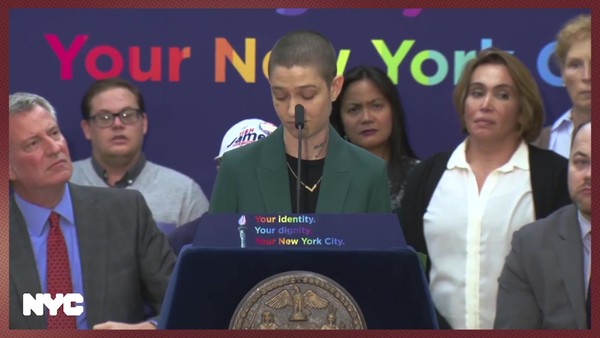Innovation > Innovation
DEAF 911
SAATCHI & SAATCHI WELLNESS, New York / St. Ann’s Community and Church for the Deaf / 2019
Awards:
Overview
Credits
Overview
Why is this work relevant for Innovation?
Deaf 911. The emergency mobile app that gives deaf people a voice. It brings life-saving possibilities of the mobile digital age into the hands of nearly 38 million deaf and hard-of-hearing (HOH) people in the United States.
Its unique application of speech-to-text technology combined with smart reply messaging reduces call time by up to 80% compared to existing emergency deaf devices and services.
Deaf 911 will greatly impact the lives of deaf people in the US by effectively connecting them to 911 dispatchers in as little time as it takes hearing people.
Background
Nearly one million people over the age of five in the United States are deaf. And 37.5 million hard-of-hearing (HOH) individuals, aged 12 and over, suffer from severe hearing loss and poor speech clarity. For this group of more than 10% US population, communicating over the phone during an emergency can be challenging.
While texting on mobile smartphones has opened doors for the deaf, they have limited options when it comes to calling for help. Text-to-911 only exists in less than 1/10 of the country. Relay-operator calls that utilize third-party interpreters take at least three minutes. Teletypewriters weighing approximately 10 pounds take more than eight minutes.
Precious moments can mean the difference between life and death during a heart attack, robbery, domestic abuse incident or natural disaster.
No technological solution currently exists that allows the deaf to call 911 in a timely and affordable manner—until now.
Describe the idea
Deaf 911. The emergency mobile app that gives the deaf a voice. It brings life-saving possibilities of the mobile digital age into the hands the millions of deaf and HOH people in the United States.
With its unique application of speech-to-text and text-to-speech technology, the deaf can call and speak directly to 911. And 911 can text back. And it does so in real-time, in just 30 seconds—roughly the same amount of time as it does for hearing people.
The app can also provide quick response to questions with the help of smart reply messaging. By researching the most common responses, our messaging options save even more valuable seconds by replacing actual texting with a simple tap, or two. And location details are also delivered immediately.
Designed specifically for the deaf or anyone with speech clarity conditions, Deaf 911 is free. Available on any smartphone.
What were the key dates in the development process?
Deaf 911 Development Milestones:
Discovery: Perform interviews and competitive analysis to understand opportunities
10 October 2018
Definition: Set scope, prioritizes, and timeline for product development
07 December 2018
Concept Development and Testing
10 January 2019
Prototype and Platform Development
15 March 2019
Quality Assurance Testing
18 November 2019
Beta Release
17 January 2020
Usage Analytics Optimization & Upgrade
21 February 2020
General Release
14 April 2020
Describe the innovation/technology
Deaf 911 is an iOS and Android mobile app downloaded to any smartphone that collects user-generated and emergency information via text-form upon registration.
It operates by placing a regular mobile call to the traditional 911 service, and translating the user’s touch input into voice for the 911 operator, and then converting the operator’s responses into text which the user can read.
The app is designed to allow quick communication of common types of emergencies, a user’s current location, and other pre-collected data with just a few taps. The user can also type to the 911 operator at any time or use the predictive responses to communicate the emergency with its smart reply messaging feature.
The app’s emergency pick list includes fire, assault and robbery links. Its conversational interface is simple and direct while establishing a unique brand look and feel.
Deaf 911 utilizes assistive technology which combines TTS and STT to create clear two-conversations between deaf people and 911 dispatchers. It also serves as a compatible enhancement to Text-to-911, once this system is readily available.
Its design and features create a much-needed tool that allows the deaf and hard-of-hearing (HOH) to increase speed and stability greatly needed in emergency situations.
Describe the expectations/outcome
Deaf 911 will be available in April 2020. Influencers in the deaf community people have already been experiencing its benefits as testers with early access to design at schools, universities and community centers.
While the app works with existing voice-dependent 911 call centers, emergency operations centers (EOC), and public safety answering points (PSAP) throughout the US and requires no adjustment on their end, our testing platform invites any feedback from these emergency systems bodies.
Deaf and hard-of-hearing (HOH) innovators at Gallaudet University and the National Technical Institute for the Deaf (NTID): support Deaf 911.
The emergency mobile app that gives the deaf a voice is currently in development with plans to offer multi-language capabilities. With its capacity to dramatically reduce the time-called for emergency services, we expect the following outcomes post launch:
• 2-10% reduction in mortality
• 6.9% reduction in emergency-related healthcare costs
• 20% reduction in property damage
More Entries from Early Stage Technology in Innovation
24 items
More Entries from SAATCHI & SAATCHI WELLNESS
24 items





